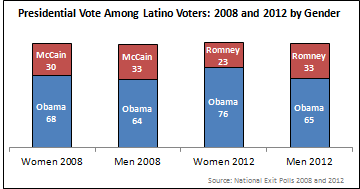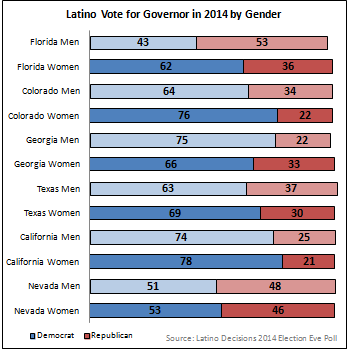The 2014 election held great possibilities for those of us who study Latina politics, both because Latina/o political participation in the 2012 election proved to be a decisive factor in the electoral outcomes of several battleground states and ultimately the reelection of President Obama, but equally because Latinas were driving the increased turnout and support for Democrats.
During the presidential elections of 2004-2012, there was evidence of a significant gender gap in Latina/o political attitudes and participation which is examined in Bejarano’s book, The Latino Gender Gap in U.S. Politics. Overall, Latinas demonstrated a modern gender gap, with more liberal political views and behaviors than their male counterparts. In other words, the gender gap among Latinas/os reflected a difference between Latinas and Latino males on the depth of their support for Democratic candidates and issues and not on a partisan divide, as exists within the national gender gap among white voters. Latino Decisions has noted that both Latinas and Latinos overwhelmingly supported Democratic candidates and issues, and the tracking data compiled over the 2012 elections suggested that more than 50 percent of both Latinas and Latinos consistently preferred Obama to Romney. This had far-reaching political implications for major political parties as they tried to mobilize increased political support from the Latina/o population.
The partisan gender gap for Latinas/os reached a high in the 2012 election, which was the highest gap among all racial/ethnic groups at 11 points.

There were also larger proportions of Latinas than Latino males that voted for Obama in both 2008 and 2012 (National Exit Poll). Therefore, this Latina/o partisan gender gap was most clearly evident in the 2012 Presidential election.
A closer analysis of this partisan gender gap shows that more Latinas reported a Democratic identity than Latino males in the 2012 Election Eve Poll. There were also significant gender gaps in Latinos’ reported electoral support of the Democratic Party in 2012. Latinas were more likely than Latino males to report high electoral support for both President Obama and the Democratic congressional candidates in the election (2012 Election Eve Poll).

Results from the 2014 Election Eve Poll suggests the continued presence of a Latina/o gender gap, particularly in competitive state races with a substantial Latina/o electorate. However, the pattern of voting differences between Latinas and Latino males took a slightly different form than 2012. In several competitive Gubernatorial and Senate races, Latinas continued to support Democratic candidates in higher numbers than Latinos (see specifically gubernatorial races in Colorado, Illinois, Florida and Texas, and Senate races in Colorado, Illinois, Texas, and North Carolina). However, the reverse pattern of Latinas outpacing Latino males in support of Republican candidates was also in effect in both the Gubernatorial and Senate races in Kansas and Georgia, as well as the race for Governor in Arizona, though that race was not considered competitive. [Election Eve Poll 2014 senate and governor vote by gender HERE]

In the Florida Gubernatorial race, not only did Latinas provide significantly more electoral support to the Democratic candidate (Crist) than Latino males– producing a 19 point difference – but the difference between the two also reflected a partisan divide as 52% of Latino males supported the Republican candidate (Scott) while 62% of Latinas supported Crist. In other words, the Latina/o gender gap mirrored the national gender gap in Florida as the Latina electorate support swung disproportionately Democratic, and a majority of Latino males supported the Republican candidate. Yet, it’s difficult to draw larger conclusions about the gender gap from the Governor’s race in Florida given the anomaly of Crist’s history as a reigning Republican in the state and his recent shift to running as an Independent and ultimately a Democrat. However, the large contingent of Latino voters who supported the Republican candidate in Florida as well as Republican Brian Sandoval’s re-election in Nevada suggests there are partisan gains to be made for Republicans among Latino voters.

In the end, the gender gap appears least salient in states where the races were non-competitive. This includes the California race for Governor where Democrat Jerry Brown defeated Republican Neal Kashkari 59-41 (and the difference in support for Brown was only 4points), as well as the Texas Senate race where Republican John Cornyn defeated Democrat David Alameel 62-34( and the difference in Democrat support is also only 4 points). The smallest difference appears in the Nevada race for Governor where Republican Brian Sandoval handily wins re-election over Democrat Robert Goodman and there is at best a 2 point difference in Latina/o support for the Democratic candidate.
Ultimately, if both the 2008 and 2012 elections cemented the significance of the Latina vote (both in terms of turnout and strength of support for Democratic candidates) then 2014 demonstrated the costs to Democrats when that support fades. Put simply, Democrats paid for their lackluster support on immigration, and scaled back targeting and mobilization campaigns aimed at Latinas/os with a loss in voter enthusiasm, turnout, and electoral support.
Christina Bejarano is an Associate Professor of Political Science at the University of Kansas. Her book entitled The Latino Gender Gap in U.S. Politics (2014) was published by Routledge Press. Anna Sampaio is Associate Professor of Ethnic Studies and Political Science at Santa Clara University, her extensive research on gender, immigration, and Latina/a politics has been published numerous academic journals, books, and edited volumes. Sampaio’s most recent work is featured in Gender and Elections: Shaping the Future of American Politics (eds. Susan J. Carroll and Richard L. Fox, Cambridge University Press).

